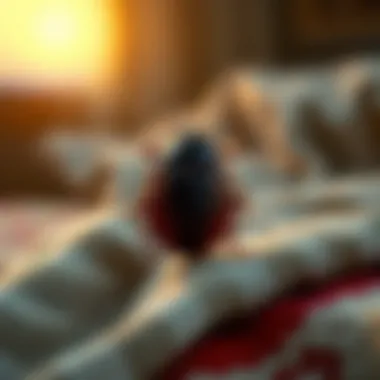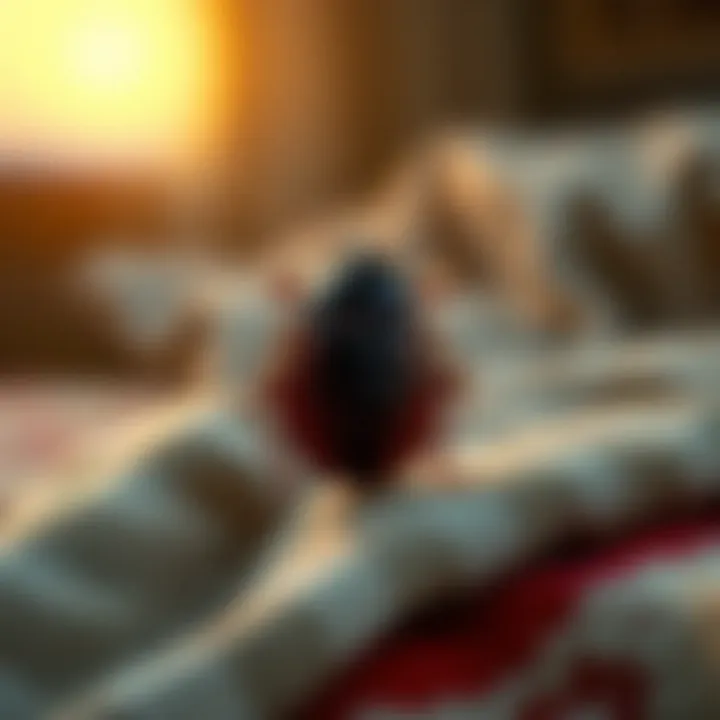Safe Bed Bug Killer: Strategies for Effective Elimination


Intro
Dealing with bed bugs can feel akin to waging a never-ending war. These pests, small yet determined, seem to thrive in the corners of our beds and crevices of our homes, feeding on our very peace of mind. Understanding how to properly identify these unwelcome visitors is the first crucial step in managing an infestation. With awareness and proactive measures, a homeowner can reclaim their space and ensure a restful night's sleep without the constant worry of bites and discomfort.
Pest Identification
Detailed Descriptions of Common Pests
Bed bugs, scientifically known as Cimex lectularius, are tiny, wingless insects typically measuring about a quarter of an inch in length—roughly the size of an apple seed. Their coloration tends to shift from a rust-brown to a deep red after a meal.
These critters are nocturnal by nature, preferring to emerge under the cover of darkness. Their bodies are flat, an adaptation that allows them to hide easily in the seams of mattresses, furniture, and even tiny nooks in walls.
Signs and Symptoms of Infestations
Identifying the presence of bed bugs hinges on recognizing specific signs:
- Bite Marks: Often resulting in red, itchy welts, these are usually clustered in batches or lines on exposed skin.
- Fecal Stains: Small dark spots on bedding or surfaces can indicate bed bug excrement
- Shed Skins: As bed bugs mature, they shed their exoskeletons, which can be found in hiding places.
- Eggs: Tiny white eggs about the size of a pinhead can often be located in the same areas where insects reside.
"An ounce of prevention is worth a pound of cure." Understanding the signs early can save homeowners from a larger, more expensive remediation effort down the line.
Prevention Strategies
Home Maintenance Tips for Pest Prevention
Proactive maintenance can go a long way in preventing bed bug infestations. Here are some key strategies homeowners can implement:
- Regular Cleaning: Vacuuming frequently, especially in bedrooms, can help remove any potential bed bugs and their eggs.
- Seal Cracks: Check for and seal cracks in walls and baseboards to limit access to hiding places.
- Monitor Upholstery: Inspect sofas and chairs, particularly around seams, for signs of bed bugs.
- Manage Clutter: Reducing clutter can minimize hiding spots, making it harder for these pests to settle.
Natural Deterrents and Barriers
Using natural remedies can complement other methods of pest prevention. Some effective options include:
- Diatomaceous Earth: This fine powder can be sprinkled in areas of suspected infestation, as it damages the outer skeletons of bugs on contact, leading to dehydration.
- Essential Oils: Oils such as tea tree and lavender oil not only provide pleasant scents but also possess insect-repelling properties when diluted and sprayed in infested areas.
Treatment Options
In the event that bed bugs have made themselves at home, understanding treatment options is vital.
Overview of Chemical vs. Natural Treatments
The effectiveness of bed bug treatment can vary greatly between chemical and natural solutions. Chemical treatments often work faster but may come with health risks if misused. Natural treatments, while usually safer, might take longer to show results, and it is essential to be thorough.
Step-by-Step Guides for DIY Treatments
For those opting for DIY approaches, here’s a brief guide:
- Vacuum Thoroughly: Start by vacuuming all affected areas, paying special attention to bed frames and under furniture.
- Wash Fabrics: Launder bed linens and clothing in hot water and dry on high heat to kill any bugs and eggs.
- Apply Diatomaceous Earth: Dust areas where you suspect bed bugs are nesting, ensuring they come into contact with the powder.
- Use Essential Oils: Create a spray using diluted essential oils and apply it regularly in vulnerable areas.
Keeping your home pest-free doesn't have to feel like a daunting task. With the right information and strategies in place, uou can manage and even prevent future infestations effectively. Remember, staying informed is your best ally in the battle against bed bugs.
Understanding Bed Bugs
Understanding bed bugs is crucial in the fight against these uninvited pests. Bed bugs can disrupt not only our sleep but also our peace of mind. A thorough comprehension of their biology, behavior, and signs of an infestation is the key to effective control. In this article, we will explore various aspects of bed bugs—how they breed, where they hide, and how to detect their presence before they become a full-blown nuisance. This foundational knowledge is your best ally when it comes to eliminating these stubborn intruders without having to resort to harmful chemicals.
Species Overview
Bed bugs, or Cimex lectularius, are small, brownish insects that thrive on blood—specifically, human blood. They are about the size of an apple seed, making them difficult to spot with the naked eye. There are several species of bed bugs, with the most common being Cimex lectularius and Cimex hemipterus. The first one is most prevalent in temperate climates, while the second tends to be found in tropical areas. Interestingly, while these insects prefer to feed on humans, they can also feast on other warm-blooded animals.
Knowing the species helps pinpoint their behavior and preferred hiding spots, as each has unique characteristics. For example, some types are more resilient to certain environments than others. Therefore, understanding their species is the first step in tackling any bed bug problem effectively.
Life Cycle and Behavior
Bed bugs have a fascinating life cycle that includes five nymphal stages before reaching adulthood. Each stage requires a blood meal to progress. An adult female can lay hundreds of eggs during her lifetime, often placing them in discreet locations like mattress seams or behind baseboards. The resulting nymphs emerge after about a week, ready to feed and continue the cycle.
Their behavior further complicates matters. Bed bugs are primarily nocturnal and prefer to stay hidden during daylight hours. They take cover in a variety of crevices around beds, furniture, and even electrical outlets. Understanding these habits can help you identify potential breeding grounds and hotspots in your home. After all, knowing where they hang out is half the battle.
Signs of Infestation
Detecting an infestation early is essential for effective control. You shouldn’t just rely on seeing the bugs themselves since they are experts at hiding. Here are several signs to watch for:
- Bite Marks: Small, red, itchy welts usually in a line or cluster on your skin.
- Fecal Spots: Dark spots on bedding or furniture can indicate bed bug droppings.
- Eggs and Casings: Tiny, white eggs or shed skins appear near their hiding areas.
- Unpleasant Odor: A musty smell can signify a larger infestation.
If you suspect that bed bugs have moved into your home, acting swiftly is crucial. At the first sign of trouble, you can minimize their impact.


"An ounce of prevention is worth a pound of cure," so equipping yourself with knowledge about bed bugs is essential for effective elimination.
Health Risks Associated with Bed Bugs
When it comes to bed bugs, understanding the health risks linked to these pests is paramount. Not only are these nuisances capable of disrupting your peace of mind, but their presence can also have serious implications for both physical and mental well-being. Recognizing the health aspects surrounding bed bugs can assist in swift identification and application of effective control methods, thus safeguarding you and your loved ones.
Physical Reactions and Allergies
Bed bugs may be small, but their bite can create a big ruckus. For many individuals, encountering these blood-sucking critters results in a barrage of physical reactions. An allergic reaction to bed bug bites can range from mild irritation to severe allergic responses. The most common reaction, however, is itching, redness, and swelling at the site of the bite. In some cases, a small percentage of the population can experience intense discomfort, even leading to blistering.
The bite from a bed bug isn’t exactly like a mosquito bite. Recognizing the difference can be crucial. While mosquito bites often resolve within hours, bed bug bites may take days or even weeks to calm. Some people find themselves dealing with secondary infections as a consequence of scratching, which can necessitate medical intervention.
Moreover, if someone is particularly sensitive, it’s not uncommon for them to develop a rash or experience systemic reactions. In the worst-case scenarios, infections that require hospitalization can occur. With such varied reactions, employing effective control methods becomes a necessity; the sooner you act, the fewer the health risks you may face.
Psychological Effects
Delving deeper than skin deep, the presence of bed bugs can gnaw away at one's mental state. The psychological impact may not be as visible as a rash, but it is just as significant. An individual dealing with a bed bug infestation might find themselves navigating feelings of anxiety, insomnia, and even depression. The constant worry about being bitten, along with the stress of eradicating these pests, can weigh heavily on one's mind.
Stories abound of individuals losing much sleep over these bugs, their minds racing at night while visions of tiny, crawling creatures invade their thoughts. This loss of sleep can lead to a domino effect, affecting daily productivity, relationships, and overall quality of life. Moreover, the stigma associated with bed bugs—often wrongly equating infestations with poor hygiene—can extend one’s distress, leading to feelings of shame.
"A bed bug problem can quickly become a mental health issue. The psychological toll can be just as disturbing as the physical effects of bites."
Understanding these psychological repercussions is essential for homeowners and families. If left unaddressed, the strain on one’s mental health can complicate efforts to deal with the physical infestation. A well-rounded approach to dealing with this issue includes not just pest control strategies but also a focus on mental well-being, underscoring the importance of support systems during such trying times.
Identifying Safe Bed Bug Killers
Identifying safe bed bug killers is the bedrock of effectively managing and eradicating infestations while ensuring the health and safety of your family and pets. Various options exist, ranging from natural remedies to targeted chemical solutions. Each method carries its own set of benefits and considerations, making it important to determine what works best for your personal circumstances. To ensure a systematic and sensible approach, understanding the differentiations between these options can significantly influence your pest control journey.
Natural solutions often appeal to those who prefer less chemical exposure, while professional-grade products can provide faster, more immediate results. When making choices about how to deal with bed bugs, the necessity to discern a safe option that aligns with your values cannot be overstated.
Natural Remedies
Natural remedies are gaining traction as safe yet effective solutions for dealing with pesky bed bugs. These options not only provide a means to eliminate the invaders, but they also often present fewer health risks, making them a strong consideration for households looking to maintain a healthy living environment.
Essential Oils
Essential oils have become a prominent alternative for many homeowners, tapping into nature’s arsenal for pest control. Oils such as lavender, tea tree, and eucalyptus possess properties that can repel and even kill bed bugs, making them a desirable choice for those seeking a natural approach. One of the key traits of essential oils is their ability to act as both a repellent and a killer, which boosts their effectiveness.
When utilizing essential oils, a unique feature is their pleasant scent, which is in stark contrast to traditional pesticides. However, it’s essential to note that while these oils can minimize infestations, they may not always guarantee complete eradication. Hence, they are best used as part of a broader strategy.
Diatomaceous Earth
Diatomaceous earth is another natural killer that has found favor among those looking for a non-toxic option. Essentially, it’s made from fossilized aquatic organisms, and the fine powder can be harmful to bed bugs upon contact. The key characteristic here is its ability to dehydrate insects by absorbing the oils found in their exoskeletons, eventually leading to their demise.
What sets diatomaceous earth apart is that it’s safe for humans and pets, making it an excellent choice for families. However, it does need a bit of patience when using since it may take time to work effectively. Ensuring that you apply an even layer in the right places is critical for it to be successful.
Heat Treatments
Heat treatments offer a different angle altogether, by utilizing temperature as a weapon. This method involves heating rooms or affected items to a level that is lethal for bed bugs—around 118°F (48°C) for at least 90 minutes. Its strength lies in its ability to penetrate small crevices and kill multiple life stages of bed bugs, making it a thorough approach.
One unique advantage of heat treatments is that it can not only kill bugs but also eliminates eggs, which is often a challenge with other methods. That said, the reliance on equipment and the potential decorating impact on your home’s fabric or structure can pose challenges to some homeowners.
Chemical Pesticides
While natural remedies are appealing, chemical pesticides remain a staple in the battle against bed bugs, especially for severe infestations. The advantage here lies in their potency, which is engineered to target these pests directly. However, this comes with its own set of considerations that need careful consideration.
Low-toxicity Formulations
Low-toxicity formulations of pesticides are designed with safety in mind, targeting bed bugs effectively while minimizing health risks to humans and animals. The core feature of these products is to provide an efficient solution without the harsh exposure associated with traditional pesticides.
This balance is crucial for those worried about chemical exposure in their living environments. Nonetheless, it’s essential to apply these formulations as directed to achieve the best results. Despite their lower toxicity, thoroughness in application remains vital to ensure success.
Residue-Free Products
Residue-free products serve as an appealing alternative in a world where health-conscious consumers are looking for safer options. These products are designed to provide the required effectiveness without leaving hazardous remnants on surfaces. The primary attribute of residue-free pesticides is their convenience, allowing for quick room reoccupation after application.
However, it’s worthwhile to be mindful that while these products can indeed be effective, their slight variation in results compared to traditional pesticides sometimes means you’ll need to use them in conjunction with other methods to see desirable outcomes.
In summary, knowing how to identify safe bed bug killers is crucial. Whether you choose natural remedies or chemical options, weight their unique characteristics, advantages, and disadvantages—aligning them with your situation can pave the way towards successfully reclaiming your home from bed bugs.
DIY Strategies for Bed Bug Control
Bed bug infestations can turn your world upside down, so understanding how to tackle these pesky pests on your own is crucial. DIY strategies allow homeowners to take charge and control the situation, often without the immediate need for professional services. Not only do these methods offer potential cost-savings, but they also empower individuals to address the issues within their own space at their own pace. Moreover, many DIY methods utilize common household items, making them both accessible and effective in combating bed bugs.


Household Solutions
Vacuuming Techniques
Vacuuming is a fundamental step in any bed bug control strategy. This technique is not only pivotal for removing visible bed bugs, but it also helps in sucking up discarded skins and eggs, which can contribute to an ongoing infestation if left unattended. A key characteristic of vacuuming is its immediacy; you can respond to an infestation quickly without heavy equipment or outlandish costs.
The unique aspect of this method lies in its efficiency. A strong vacuum with a specialized nozzle can reach crevices where these bugs often hide. However, it’s important to know that while vacuuming reduces numbers, it should not be viewed as a standalone solution. Regular use is crucial to maintain effectiveness. After vacuuming, remember to dispose of the bag outdoors to prevent any bugs from escaping back into your home.
Laundry Practices
When it comes to tackling bed bugs, hot laundry practices are another powerful DIY strategy. Washing bedding, linens, and clothing in hot water effectively kills all life stages of bed bugs. The heat is a major enemy for bed bugs, making laundry a top ally in the fight against infestations.
This method’s key feature is its simplicity and practicality; everyone has laundry facilities. On the downside, it can be time-consuming to launder all linens, but the assurance that you're killing bugs is well worth the effort. Additionally, drying on high heat for about 30 minutes ensures any remaining bugs perish, enhancing the effectiveness of this practice.
Using Natural Deterrents
Sprays and Powders
Incorporating sprays and powders into your bed bug control arsenal can create a multi-faceted approach, engaging different strategies based on your circumstances. These options often consist of natural ingredients that deter or kill bed bugs while minimizing the risk of harmful chemicals in your home.
Their flexibility is a major selling point. Many of these products can be applied directly to infested areas or as preventive barriers. Despite their effectiveness, the drawback often lies in their immediate contact nature; consistent application is essential to keep the pests at bay, as they may not linger if the treatment is not maintained.
Traps
Bed bug traps serve as a monitoring tool in the battle against infestations. These traps utilize various bait methods to lure bed bugs, allowing you to gauge the intensity of an infestation and target areas that need more attention. The beauty of traps is that they offer a way to see if your other strategies are working.
The traps are a straightforward solution; however, they also have limitations. They don’t eliminate bugs but rather help assess the situation. Their passive nature means they must be combined with other preventive measures to form a comprehensive approach. Additionally, it’s essential to check traps regularly to ensure that the data they provide is timely and useful.
Implementing DIY strategies for bed bug control can make a significant difference in managing an infestation and often helps restore comfort in one’s living space.
Professional Bed Bug Extermination
Addressing a bed bug infestation can be daunting, and sometimes it's more than just the average DIY method can tackle. This is where professional bed bug extermination comes into play. Enlisting the help of experts can make the difference between a fleeting annoyance and a full-blown crisis. Professionals bring knowledge, experience, and specialized tools to the table, ensuring that these pesky intruders don’t just scurry away to plague you again later.
Important elements about professional extermination include thorough inspections, strategic treatment strategies, and follow-up care. They utilize methods that are often beyond the reach of standard household remedies, ensuring a more comprehensive approach. Benefits often include quicker results and techniques that lessen the chance of future infestations. Let's dive deeper into how to identify when it's time to call the pros and how to choose the right service.
When to Call Experts
Deciding when to turn to professionals can be a bit tricky. You might want to consider reaching out if:
- You see signs of heavy infestation: If those little bugs are popping up faster than you can swat them, it’s probably time to wave the white flag.
- Home remedies fail: If you’ve tried the natural and DIY methods but they are not giving you the results you hoped for, it may indicate you need more heftier strategies.
- Recurring problems: Spotting bed bugs multiple times can suggest you might have an established breeding ground that’s beyond your control.
- Personal limitations: If dealing with an infestation is stressing you out or you have health concerns, calling in a pro can ease your burden.
Recognizing these signals can save you from further distress and allow for a more effective approach to resolution.
Selecting a Pest Control Service
Choosing the right pest control service is crucial to ensure you get a thorough, effective, and safe elimination of bed bugs.
Licensing and Certification
When it comes to licensing and certification, these elements are non-negotiable. A legitimate pest control service should hold the necessary licenses, as this guarantees they adhere to safety regulations and industry best practices. This aspect doesn’t merely boost your confidence; it protects you legally too. Ensuring the service is certified means they have undergone necessary training and assessments to handle such infestations.
- Key characteristic: Many states require certain credentials for pest control operators, making it an essential choice when evaluating potential services.
- Advantages: Licensed companies often have insurance that covers any damages or mishaps during treatment, giving you peace of mind. A certified team is also likely to be well-versed with the latest methods and eco-friendly solutions, which is a growing concern for every responsible homeowner.
Eco-Friendly Practices
Eco-friendly practices in pest control are becoming increasingly popular for good reason. They emphasize the importance of using methods and materials that are less harmful to the environment. This can range from using naturally derived insecticides to employing techniques that limit chemical exposure to both inhabitants and the local ecosystem.
- Key feature: Services that promote eco-friendly strategies tend to cater to the health of your home environment, incorporating approaches that are safer for children and pets.
- Advantages: Implementing eco-friendly practices can minimize the carbon footprint of extermination processes. Plus, if you hire a service that prioritizes this, you may gain additional confidence knowing they take a responsible approach to pest control.
In summary, professional bed bug extermination isn’t just about ridding yourself of a nuisance. It’s a strategic step towards safeguarding your home and health, especially when the situation calls for more than what a DIY hack can achieve.
Integrating Prevention Strategies
In the battle against bed bugs, prevention is often a missed opportunity. Many individuals assume that one-time treatments will suffice, but integrating prevention strategies can be the cornerstone of a long-term solution. Gaining control over these persistent pests begins with awareness and proactivity. Effectively preventing an infestation is less about combat and more about vigilance and consistency.
Establishing routine practices can markedly reduce the chance of encountering these intruding insects. One key approach is routine inspections, which can significantly aid in identifying potential problems before they escalate. This involves examining not just common areas like beds and sofas, but other hidden nooks and crannies, such as behind baseboards and within electrical outlets.
“An ounce of prevention is worth a pound of cure.” — Benjamin Franklin
On a practical note, being observant during travels also plays a critical role in prevention efforts. Checking hotel rooms for signs of bed bugs upon arrival can save a whole lot of trouble. Using protective coverings for mattresses and regularly inspecting them can help, too.
Furthermore, sealing entry points is vital. Bed bugs can hitch a ride through even the tiniest of gaps. Addressing these vulnerabilities not only reduces risk but also equips your home with a fortification against future encroachments.


The benefits of integrating these strategies are manifold. For on one hand, they can save you from financial strain associated with recurring treatments, and on the other, create peace of mind as your home becomes a less hospitable zone for these pests.
Moreover, implementing consistent preventive measures supports the overall effectiveness of eradication efforts. In essence, integrating these strategies is not just about safeguarding your living space; it's about cultivating a proactive mindset towards home management.
Routine Inspections
Maintaining the upper hand against bed bugs is largely about vigilance. Routine inspections come into play as a foundational element in any thorough pest management plan. This process isn't just about looking for bugs; it's about understanding their behavior and life cycle.
These inspections should happen regularly, ideally once a month, even when you don't suspect a problem. Start by carefully examining bedding, particularly seams and folds where bed bugs love to hide. If you notice small, dark spots—often bug excrement—it's wise to take immediate action.
Don't limit your search to the bedroom alone. Check the living room, particularly along the seams of couches or chairs. Inspect under cushions and in between furniture. Keep an eye on your luggage when you're back from travels; that’s the prime transport for these pests.
Here’s a checklist to ensure comprehensive inspections:
- Inspect mattresses and box springs thoroughly.
- Check baseboards, cracks, and crevices in walls.
- Look behind wall art or any furniture that’s up against the wall.
- Examine electrical outlets and light switches, as bed bugs can hide here.
Emphasize systematic findings during each inspection. Providing a written record of locations checked can be helpful, ensuring nothing slips through the cracks in future examinations. This proactive step allows one to track any potential issues over time, enabling prompt action before the situation futher escalates.
Sealing Entry Points
In the realm of pest control, sealing entry points is akin to fortifying a castle against invaders. Bed bugs are crafty little creatures that can squeeze through the tiniest of gaps—often smaller than a credit card. Hence, sealing these vulnerable spots is crucial in preventing infestations.
Begin with doors and windows, paying extra attention to misalignments or gaps. Sealing these with quality weather stripping or caulking can eliminate easy access points. Inspect plumbing and electrical conduits where they enter walls; these openings can be inviting pathways for bed bugs seeking shelter.
Here’s a quick list on how to seal entry points:
- Utilize caulk around windows and doors.
- Install weather stripping at the base of doors.
- Cover vents with screens to thwart entry via ducts.
- Use outlet covers to prevent access through electrical outlets.
Additionally, being mindful of the items you introduce into your home is important. Second-hand furniture should always be inspected and treated before bringing it into your living space. Taking these steps greatly increases the difficulty for bed bugs to find a place to call home.
Regularly checking and reinforcing these barriers can help tremendously in keeping those unwanted guests at bay. Remember, in pest control, a little prevention goes a long way.
Environmental and Safety Considerations
Impact on Health
When tackling a bed bug infestation, the concern for personal and family health cannot be overlooked. Bed bugs, while not known to transmit diseases, can lead to significant physical discomfort, which can escalate quickly. Skin reactions from bites can cause rashes or allergic reactions, keeping you awake at night and impacting overall well-being. In addition, the psychological stress resulting from an infestation can lead to anxiety, insomnia and even depression.
On the flip side, the methods we choose to eradicate these pests can also influence health. Synthetic chemical pesticides often come with toxic side effects, not just for bed bugs, but for humans and pets living in the same space. Choosing safer alternatives is a pathway to not just eliminating pests but protecting the occupants of the home. Here are a few elements to consider that underline this impact:
- Pesticide Residues: Many chemicals leave harmful residues that can linger in the environment long after application. It's vital to select pest control methods that ensure these residues can either be avoided or are negligible.
- Long-Term Effects: Some pesticides may impact health over time, such as respiratory issues or endocrine disruption. Opting for natural remedies can often sidestep these issues altogether.
"Your health should never come secondary to pest control."
Choosing natural remedies, such as essential oils or heat treatments, minimizes exposure to harmful substances while still addressing the infestation directly.
Sustainability in Pest Control
Adopting a sustainable approach to bed bug extermination is equally important as it aligns with broader ecological considerations. As homeowners increasingly embrace environmentally friendly practices, integrating these strategies in pest control is paramount. Sustainability here means balancing effective pest control with minimal ecological impact. Here are some strategies:
- Using Biological Control: This involves utilizing natural predators of bed bugs, which can control the population without chemical exposure.
- Heat Treatments: Involves raising the temperature of your home to levels that are intolerable for bed bugs, effectively eradicating them in a single go. Heat techniques do not introduce chemicals into the atmosphere.
- Encouragement of Integrated Pest Management (IPM): This strategy combines knowledge of the pest and the environment to ensure effective management with minimal impact. It involves regular monitoring and consideration of non-chemical methods.
By prioritizing sustainable practices, not only do we protect our immediate environments but we also contribute to a larger effort that promotes ecological balance and public health. The more we educate ourselves on these methods, the safer our homes and our planet become.
In the end, addressing bed bug infestations should not just be about extermination but also about creating a safe and healthy living space that takes both individual well-being and the environment into account.
Closure
In wrapping up this comprehensive exploration of strategies for bed bug elimination, it becomes evident that effective pest control transcends mere eradication; it encompasses a multifaceted approach steeped in prevention and safety. As bed bugs exhibit a notable resilience, understanding the nuances of their behavior and life cycle is critical for any effective treatment. The emphasis on safe bed bug killers, whether natural or chemical, ensures that homeowners can make informed choices that prioritize health without sacrificing efficacy.
The information presented throughout this article delineates the best practices and products that are not only effective but also considerate of the health of your household. Utilizing natural remedies like essential oils or diatomaceous earth serves as an excellent first line of defense, while low-toxicity chemical options offer robust solutions for more extensive infestations. Each tactic discussed is a brick in the sturdy wall of your pest management strategy.
"An ounce of prevention is worth a pound of cure." This adage rings particularly true when dealing with intermittent pest invasions. By integrating routine inspections, sealing entry points, and employing deterrents, one can keep those tenacious little critters at bay.
In the end, a proactive approach, coupled with informed choices on bed bug killers, will not only aid in the current battle but fortify your home against future incursions. Homeowners and housewives alike can appreciate the balance of effectiveness and safety—an essential consideration for any household.
Recap of Effective Solutions
Throughout this discourse, we have elaborated on multiple methods and approaches to combat bed bugs. Here are the key takeaways:
- Natural Remedies: Essential oils like lavender and tea tree oil, alongside diatomaceous earth, provide safe, eco-friendly options for treatment.
- Chemical Pesticides: Choosing low-toxicity formulations ensures effective extermination with minimal health impacts.
- DIY Techniques: Regular vacuuming and meticulous laundry practices can drastically reduce bed bug visibility.
- Professional Help: Knowing when to bring in experts can save time and ensure that infestations are handled comprehensively.
In each solution, there’s a clear focus on safety and sustainability, ensuring households can maintain their pace of life without the worry of harmful chemicals lingering in their environment.
Encouraging Safe Practices
Adopting safe practices goes beyond merely addressing an existing bed bug issue. It promotes a deterrent mindset that can protect your home in the long run. Here are some key practices to integrate:
- Regular Inspections: Conducting periodic checks, especially in high-risk areas like the bedroom and living room, can help catch infestations early.
- Educating Household Members: Everyone in the home should be aware of the signs of bed bugs and the measures to take instantly upon detection.
- Maintaining Cleanliness: Keeping clutter at bay not only deters bed bugs but makes it easier for the eye to catch potential problems.
- Using Protective Covers: Encasements for mattresses and pillows provide added protection against these nuisances.
By fostering an environment of awareness and preventative measures, each household can effectively minimize the risk of infestation. A proactive stance is essential for not just fighting bed bugs today, but ensuring a bug-free tomorrow.



